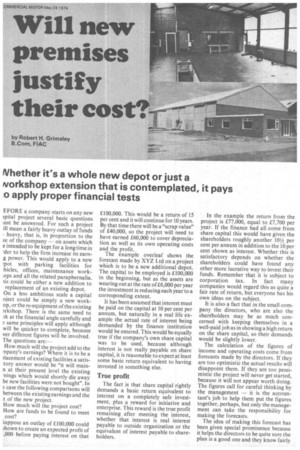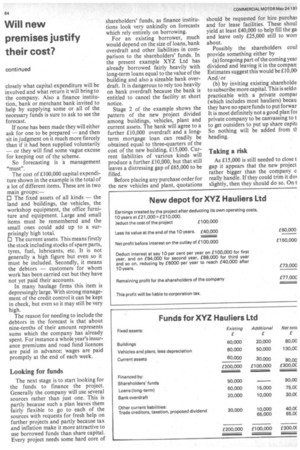Will new premises justify their cost?
Page 65

Page 66

Page 67

If you've noticed an error in this article please click here to report it so we can fix it.
by Robert H. Grimsley B.Com, FIAC
fVhether it's a whole new depot or just a workshop extension that is contemplated, it pays o apply proper financial tests
EFORE a company starts on any new ipital project several basic questions Lust be answered. For such a project ill mean a fairly heavy outlay of funds heavy, that is, in proportion to the ze of the company — on assets which e intended to be kept for a long time in -der to help the firm increase its earng power. This would apply to a new !pot with parking facilities for .hides, offices, maintenance workops and all the related paraphernalia. is could be either a new addition to replacement of an existing depot. On a less ambitious scale a capital oject could be simply a new workop, or the re-equipment of the existing )rkshop. There is the same need to Dk at the financial angle carefully and .t same principles will apply although will be quicker to complete, because ver different figures will be involved. The questions are— How much will the project add to the ripany's earnings? Where it is to be a )Iacement of existing facilities a satis:tory answer would be "it will mainn at their present level the existing mings which would shortly die away he new facilities were not bought". In s case the following comparisons will between the existing earnings and the .t of the new project.
How much will the project cost? How are funds to be found to meet cost?
;Impose an outlay of £100,000 could ihown to create an expected profit of ,000 before paying interest on that £100,000. This would be a return of 15 per cent and it will continue for 10 years. By that time there will be a "scrap value" of £40,000, so the project will need to have earned £60,000 to cover depreciation as well as its own operating costs and the profit. The example overleaf shows the forecast made by XYZ Ltd on a project which is to be a new additional depot. The capital to be employed is £100,000 in the beginning, but as the assets are wearing out at the rate of £6,000 per year the investment is reducing each year to a corresponding extent.
It has been assumed that interest must be paid on the capital at 10 per cent per annum, but naturally in a real life example the actual rate of interest being demanded by the finance institution would be entered. This would be equally true if the company's own share capital was to be used, because although interest is not really payable on share capital, it is reasonable to expect at least some basic return equivalent to having invested in something else.
True profit
The fact is that share capital rightly demands a basic return equivalent to interest on a completely safe investment, plus a reward for initiative and enterprise. This reward is the true profit remaining after meeting the interest, whether that interest is real interest payable to outside organization or the equivalent of interest payable to shareholders. In the example the return from the project is £77,000, equal to £7,700 per year. If the finance had all come from share capital this would have given the shareholders roughly another 101/2 per cent per annum in addition to the 10 per cent shown as interest. Whether this is satisfactory depends on whether the shareholders could have found any other more lucrative way to invest their funds. Remember that it is subject to corporation tax. In fact many companies would regard this as quite a fair rate of return, but everyone has his own ideas on the subject.
It is also a fact that in the small company the directors, who are also the shareholders may be as much concerned with keeping themselves in a well-paid job as in showing a high return on the share capital, so their demands would be slightly lower.
The calculation of the figures of income and operating costs come from forecasts made by the directors. If they are too optimistic the actual results will disappoint them. If they are too pessimistic the project will never get started, because it will not appear worth doing. The figures call for careful thinking by the management — it is the accountant's job to help them put the figures together, perhaps, but only the management can take the responsibility for making the forecasts.
The idea of making this forecast has been given special prominence because it helps the directors to be quite sure the plan is a good one and they know fairly closely what capital expenditure will be involved and what return it will bring to the company. Also a finance institution, bank or merchant bank invited to help by supplying some or all of the necessary funds is sure to ask to see the forecast.
If none has been made they will either ask for one to be prepared and then sit in judgment on it much more fiercely than if it had been supplied voluntarily or they will find some vague excuse for keeping out of the scheme.
So forecasting is -a management "must".
The cost of £100,000 capital expenditure shown in the example is the total of a lot of different items. These are in two main groups: 0 The fixed assets of all kinds the land and buildings, the vehicles, the workshop equipment, the office furniture and equipment. Large and small items must be remembered and the small ones could add up to a surprisingly high total.
0 The current assets. This means firstly the stock including stocks of spare parts, tyres, fuel, lubricants, etc. It is not generally a high figure but even so it must be included. Secondly, it means the debtors customers for whom work has been carried out but they have not yet paid their accounts.
In many haulage firms this item is depressingly large. With strong management of the credit control it can be kept in check, but even so it may still be very high.
The reason for needing to include the debtors in the forecast is that about nine-tenths of their amount represents sums which the company has already spent. For instance a whole year's insurance premiums and road fund licences are paid in advance; wages are paid promptly at the end of each week.
Looking for funds
The next stage is to start looking for the funds to finance the project. Generally the company will use several sources rather than just one. This is partly because such a plan leaves them fairly flexible to go to each of the sources with requests for fresh help on further projects and partly because tax and inflation make it more attractive to use borrowed funds than share capital. Every project needs some hard core of shareholders' funds, as finance institutions look very unkindly on forecasts which rely entirely on borrowing.
For an existing borrower, much would depend on the size of loans, bank overdraft and other liabilities in comparison to the shareholders' funds. In the present example XYZ Ltd has already borrowed fairly heavily with long-term loans equal to the value of the building and also a sizeable bank overdraft. It is dangerous to rely too heavily on bank overdraft because the bank is entitled to cancel the facility at short notice.
Stage 2 of the example shows the pattern of the new project divided among buildings, vehicles, plant and current assets. The bank will agree to a further £10,000 overdraft and a longterm mortgage loan can readily be obtained equal to three-quarters of the cost of the new building, £15,000. Current liabilities of various kinds will produce a further £10,000, but that still leaves a distressing gap of £65,000 to be filled.
Before placing any purchase order for the new vehicles and plant, quotations should be requested for hire purchas and for lease facilities. These shoul yield at least £40,000 to help fill the ga and leave only £25,000 still to worr about.
Possibly the shareholders coul provide something either by (a) foregoing part of the coming year dividend and leaving it in the compan Estimates suggest this would be £10,001 And/or (b) by inviting existing shareholde to subscribe more capital. This is seldo practicable with a private compar (which includes most hauliers) becau they have no spare funds to put forwar It is most definitely not a good plan for private company to be canvassing to t to get outsiders to put up share capit‘ So nothing will be added from ti heading.
Taking a risk
As £15,000 is still needed to close t gap it appears that the new project rather bigger than the company c really handle. If they could trim it dm slightly, then they should do so. On t ther hand if it is a question of "all or othing" a really determined board of irectors would decide to go ahead and retch their resources to the utmost mit. They would be taking a chance hich is really not to be recommended y prudent advisers and if the gap had !en any greater than this (15,000 short a total requirement of £300,000 eluding the existing capital) it would ive been highly dangerous.
Ideas for making up that corntratively small difference might elude:— (a) Pushing all customers to pay their :counts more promptly. Bringing the Trage settlement time down by one :ek from nine weeks to eight weeks ight show £5,000 improvement.
(b) Relying even more heavily on ise or hire purchase, possibly another ,000.
(c) Pressing the bank manager to ex-id his help just a little further. Methods which are positively not to recommended are: Keeping the suppliers of goods and services waiting for settlement of their accounts by longer than the agreed time.
Pushing the customers too hard for prompt settlement; the difficult aim is to keep a neat balance between pressing for early payment and accepting reasonable delay.
Pretending in the forecast that the outlay will be less than is really the case.
igible for relief
3n a long-term basis there is really thing to equal retaining the corny's own profit as a source of funds. e trouble is, it is too little and too w, especially in view of the combined -dens of tax and inflation.
testrictions on hire purchase iounced in the mini-Budget of cember 1973 are aimed at retail and nestle trade and should have no iificant effect on industrial hire purse apart from some tightening up of timum deposits and maximum ayment times.
fie high interest rates charged by iks and other lenders during the early nths of 1974 have not been fully reted by corresponding increases in the rges of most finance institutions proing hp and lease facilities, so these 'e tended to become relatively more 'active although rates still differ ely from one firm to another.
nterest on all forms of loans, hp rges and lease rents for business pures continue to be eligible for income relief and they are not affected by the I restrictions on tax relief for ;onal borrowing.




































































































































